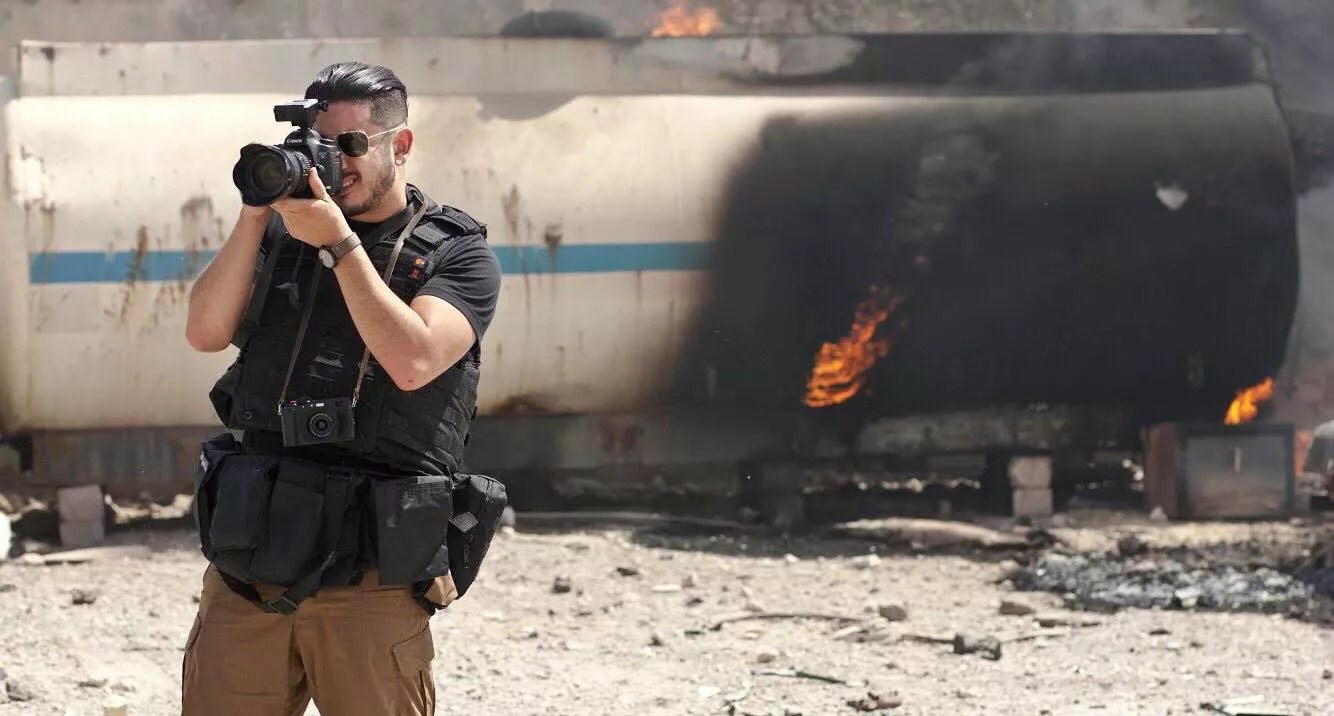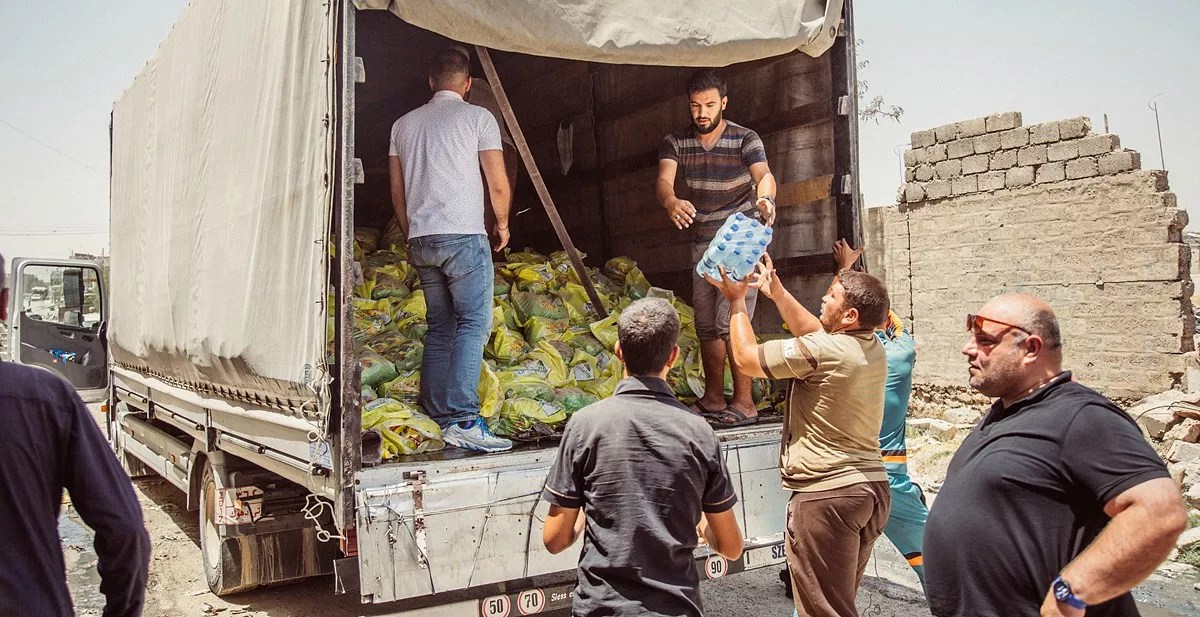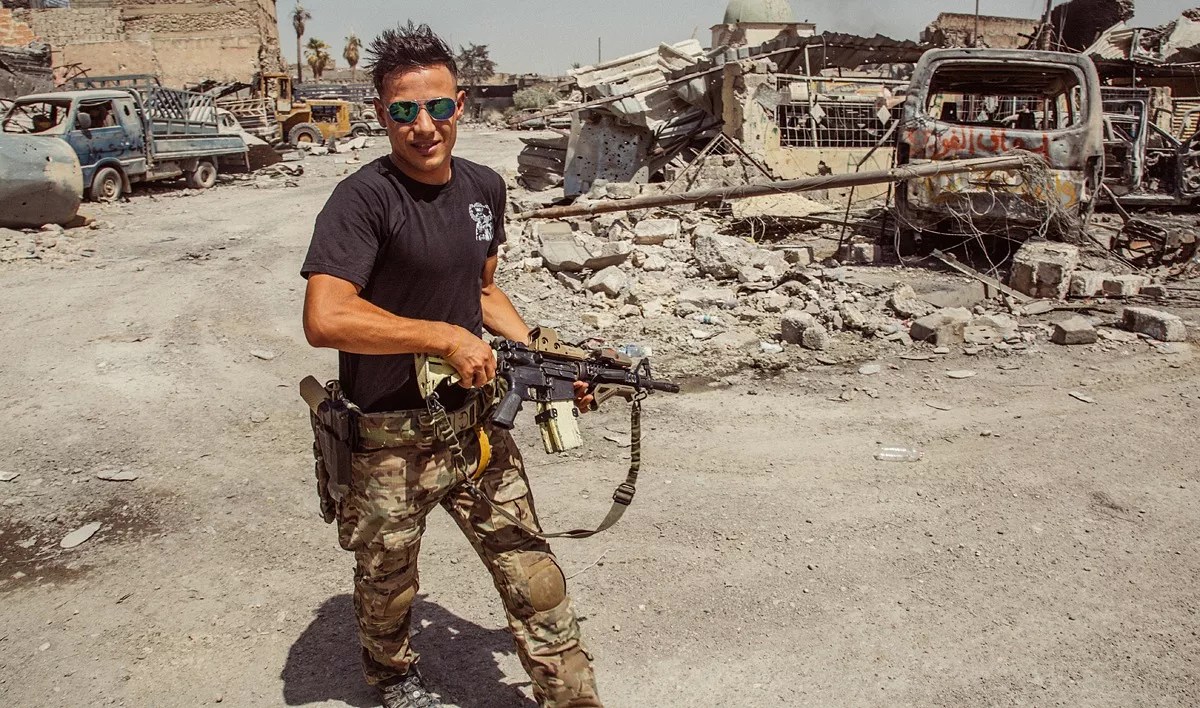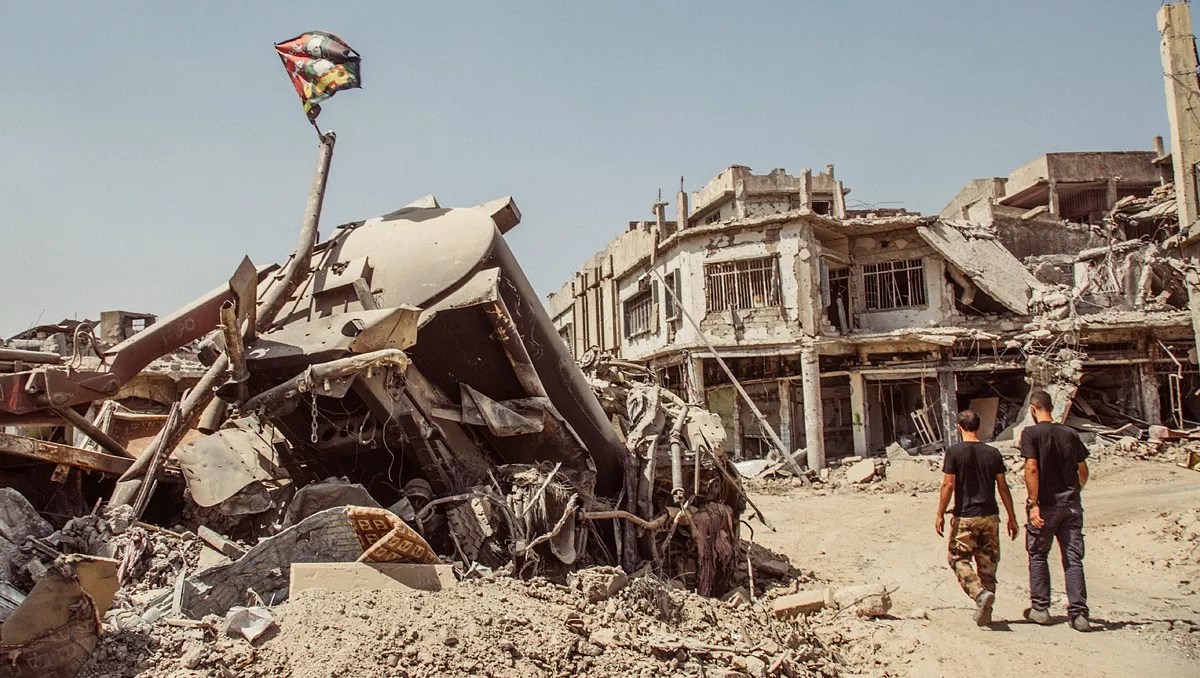
Audio By Carbonatix
Panicked that he might miss a killer shot, Jose Argueta fumbles through the pocket of his cargo pants, grasping for elusive earplugs. A couple of feet away, a sniper cradles the butt of a rifle against his cheek and stares down the lens of the telescope, his finger barely kissing the trigger. Behind him, a soldier in a T-shirt bandanna and full-body camouflage knowingly palms his ears. Suddenly, the gun jerks back, and a deafening clap turns into a shriek, like the high-pitched dial tone of a dropped call. Argueta thinks, There go my eardrums.
Argueta’s expedition to Northern Iraq was originally meant to document the ongoing humanitarian crisis in Mosul, a city that had been declared totally liberated from the Islamic State five days earlier. But after a chance meeting with Iraqi special forces, the Miami native became one of the few American photojournalists to make it to the frontlines of the war.
And as Argueta treaded deeper into the “belly of the beast,” he soon found the realities in Mosul were far less optimistic than what he’d heard reported in the media.
“It’s like Bush’s ‘Mission Accomplished’ speech,” he says of early proclamations that the city was ISIS-free.
Still jet-lagged from a 16-hour flight back to the United States, the scruffily bearded 29-year-old sips a latte in a coffee shop and scrolls through raw footage of warfare on his laptop. Though he was born and raised in Westchester, Argueta says his Guatemalan heritage helped him blend into the Middle Eastern nation. But he jokes that having Latin roots also meant he couldn’t tell his mother he was heading into a war zone.
“Latin mothers tend to worry,” he says.

Standing in front of a burning tanker, freelance photojournalist Jose Argueta photographs the frontlines of war in Mosul. See more of Jose Argueta’s photos from Mosul (warning: some images are graphic).
Lauren Rooney
After graduating from Miami International University of Art & Design, Argueta spent four years as a motion graphics artist for Univision. Though he often shot portraits and short documentaries on the side, his portfolio was limited to low-budget films of nightclubs and a New York barbershop.
Inspired by the greats of conflict photography – among his idols are Tim Hetherington, who was killed in Libya, and Lynsey Addario – Argueta attended a recent conflict photography workshop led by former soldiers and war reporters in Spain.
“We practiced first aid, we learned military tactics, and we slept outside in the mountains of Andalusia for five days,” he says. In the midst of it, he became close friends with Sam Lees and Lauren Rooney, two tattooed photographers from London.
With an old connection located in Erbil – an aid volunteer by the name of Mohammed Dylan – Argueta invited Lees and Rooney on a reporting trip to Iraq. Dylan, whose own house in Ramadi was blown up a couple of years ago, worked for Wasel Tasel, a nonprofit that often partnered with other humanitarian organizations, such as One World Medical Mission in Mosul. With Dylan offering to be their fixer, Argueta decided Iraq was the perfect journalism opportunity.
“We were completely self-funded,” he says. “We had no protection or support, but for a photographer, this was the dream.”
After reports early this month that the city was already liberated, Argueta decided he would photograph One World Medical’s distribution of care packages to residents in a small town in western Mosul. After flying in on July 12, the crew of three met with Dylan in Erbil, the capital city of Iraqi Kurdistan, also known as “the Oasis of War.”
“It’s so peaceful there, with the beautiful coffee shops and malls,” Argueta says. “You’d never know that a couple miles away is the ISIS capital.”
In June 2014, leader of the Islamic State, Abu Bakr al-Baghdadi, stood at the pulpit of al-Nuri, a 12th-century mosque in Mosul, and proclaimed himself caliph of the territory straddling Iraq’s and Syria’s borders. With that, Mosul, along with de facto capital Raqqa in Syria, became an ISIS stronghold. In October 2016, 100,000 troops, including Iraqi forces, Kurdish Peshmerga fighters, and U.S.-backed coalitions, led a military offensive to retake Iraq’s second-largest city from ISIS militants. By the end of the nine-month campaign, thousands of civilians had died, almost a million others were displaced, and 32,000 houses were destroyed.
“In order for an area to get liberated, everything needs to be destroyed,” Argueta says.
On July 10, Iraqi Prime Minister Haider al-Abadi, outfitted in a black military uniform, waved a flag and declared Mosul liberated from the Islamic State. The announcement had been delayed by a day because soldiers reported that a pocket of ISIS fighters still remained in the old city on the western bank of the River Tigris. U.S. forces celebrated with the Iraqis on a strategic victory that signified the extremist organization’s waning power, but also noted the city needed to be back-cleared of explosive devices and possible ISIS fighters in hiding.
Though the fighting was said to be over, driving into Mosul involved seven checkpoints with an average wait of 15 minutes. On July 15, packed into the back of a small van with their seven cameras, Argueta, Lees, and Rooney sat suited in press jackets, helmets, and Kevlar body armor. At the first checkpoint, the crew noticed that officers of the Kurdish army were examining each vehicle. “Mohammed quickly turns around and tells us: ‘By the way, you’re not photographers; you’re volunteers. Hide your stuff under the chairs.'” Hearing this, the three photographers ripped off their press patches and shoved their equipment under their seats.
Checkpoint after checkpoint, the van stopped. By the third, a group of soldiers surrounded the vehicle. While a nervous Dylan tried to explain that his group had already been approved to move forward, a blast rang out. Behind them, an officer had gotten into a squabble with another driver. Warning shots were fired. Distracted, the soldiers cleared the road, and immediately Dylan slammed the gas pedal. As the van sped away, he turned to his three disoriented passengers, smiled, and said, “Welcome to Mosul.”
By the time the crew reached the last checkpoint, Argueta had already begun to see the remnants of destruction. ISIS had blown up all of the bridges entering Mosul, but one still stood: a bridge that the Iraqi military had rebuilt and now patrolled.
“Mohammed looked terrified,” Argueta says. “All press had been turned back. Another fixer told us: ‘Don’t even try.’ There was just no way we were getting in.” But after a 30-minute detainment, Argueta, Lees, and Rooney found themselves crossing the bridge into Mosul, passing the “point of no return.”
Creaking over dust and rubble, the van drove deeper into Mosul. On its flanks, fires blazed and blasted cars lay overturned. In the distance, a blackened mountain of rubble replaced what used to be the University of Mosul. Along its perimeter, students sat, reading their textbooks against the ruins. “It was like an apocalypse,” Argueta says, “a scene straight out of Mad Max.”
A few minutes later, the crew entered the small town in western Mosul. As they exited the van, a distribution truck rolled in. What began as a crowd of 20 soon turned into hundreds. People swarmed the road, flashing their ID cards, and humanitarian workers passed down water bottles and bags of food. Meanwhile, on the outskirts of the compound, little boys in soccer jerseys play-fought near a white car with cracked windows, mothers in black abayas cradled their children, and elderly men in light-blue thawbs rested against brick walls.
Hearing the rapid shutter of Argueta’s Canon DSLR, an old man hobbled over to speak with him. “He came to make sure that I knew they were decent people, not savages. He wanted to explain that if people were acting wild, it was because they were really hungry,” Argueta says. “He told me that they’d been eating cats.”

See more of Jose Argueta’s photos from Mosul (warning: some images are graphic).
Jose Argueta
Children scrambled to get their photo taken, and Argueta enthusiastically obliged. But after 40 minutes, Dylan announced it was time to leave. Thinking there might be a security threat, because ISIS often sent drones to target crowds, Argueta and the rest of the crew quickly boarded the van and drove off.
Unexpectedly, they pulled up to a three-story house ten minutes later. Spray-painted on the front wall was the phrase, “Fuck ISIS.” Dylan told the three photographers to leave their cameras outside and shepherded them toward the mysterious building. Suddenly, a band of muscled men in black T-shirts and camo pants emerged. One fired his rifle into the air, while another swung out an RPG. It was a lighthearted scare, Argueta insists. It was a welcome into the home of an Iraqi special forces general.
“It was unbelievable,” Argueta says. “Mohammed was trying to get us permission to go into the old city where the fighting was happening.” The soldiers offered them a lunch of rice, beans, and pita. Eventually, the soldiers agreed to escort the “volunteers” into the frontlines.
Never expecting he’d make it to the warfront, Argueta realized he’d left his helmet behind. With only body armor protecting his torso, he clambered into the back of a decommissioned ambulance. At 1 p.m., the convoy headed into the old city.

See more of Jose Argueta’s photos from Mosul (warning: some images are graphic).
Jose Argueta
First, the soldiers made a quick pit stop. As Argueta climbed down from the ambulance, the sun was strong and the air eerily silent. A few meters away, a charred tanker burned. Shattered rods, wood, and bent rafters wasted in the streets. Despite the desolation, Argueta couldn’t help but smile: “There was this feeling that we were where every journalist wants to be.”
Minutes later, a soldier approached the photographer, asking Argueta to follow him. As the two hiked down the rocky street, they came to a garage with a rounded metal crate. It was an ISIS car bomb, Argueta says, “the kind they drive in a tank to blow up two blocks’ worth of people.”
A couple of steps farther, on a stoop, two legs dangled, stained in fecal matter and blood, the body pinned by a wooden pole and the face ripped off. As the stench of decay wafted from the body, the soldier explained. “Sometimes they leave bodies here on purpose,” Argueta says. “They’re like trophies, so that ISIS can see.”
Now seated in the back of a Land Cruiser, Argueta surveyed the bleak landscape as the convoy breached the frontlines. Though he feared he might misstep and activate a landmine, Argueta dismounted the vehicle. His footprints joined those of combat boots and Humvee wheel tracks in the sand.
In the distance, he could hear bombs blasting, the faint crackle of gunfire, and the whip of a flag dangling from a twisted pole. “The smell of death was horrendous,” Argueta says. “It was fresh destruction.”

See more of Jose Argueta’s photos from Mosul (warning: some images are graphic).
Jose Argueta
In every direction, buildings lay in wreckage, and bricks littered the sides of the road. The team sprinted from one sniper camp to another, crouching for safety and avoiding slabs of scalp with long black hair. Every once in a while, Argueta heard the faint slap of bullets hitting walls and windows.
At the first rooftop, Argueta found a group of marksmen quietly monitoring the land, their fingers ready to shoot at any movement on the ground. Desperate to photograph one shot, Argueta focused on one sniper who had needled the shaft of his gun through a hole in the ledge. More than 200 bullets hung from the rifle’s ammunition belt. Though he missed every recoil, Argueta sensed the fact that he’d witnessed persistent gunfire since he arrived was more important than the photo itself. By the time he’d met the second sniper, he was sure of it.
Argueta recalls one instance in which one of the soldiers kept repeating “Daesh, Daesh,” the Arabic acronym for ISIS: “Apparently at one point, while we were walking between these walls, ISIS was less than 40 meters away,” he says. “He wanted me to see.”
In just two hours, Argueta had collected a portfolio of photos that captured the final frontier of Mosul’s warfront. Having returned from his expedition one week ago on July 19, he finds that his observations contradict what has been widely reported in the American media.
“Back in the U.S., we hear that Mosul is liberated based on there being very few ISIS fighters left,” he says, “but from what I saw, there is still a lot of fighting going on.”
